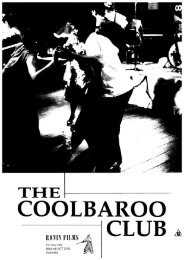to download KIDNAPPED! study guide - Ronin Films
to download KIDNAPPED! study guide - Ronin Films
to download KIDNAPPED! study guide - Ronin Films
Create successful ePaper yourself
Turn your PDF publications into a flip-book with our unique Google optimized e-Paper software.
STUDYGUIDE<br />
BY Marguerite O’Hara<br />
www.metromagazine.com.au<br />
www.theeducationshop.com.au<br />
SCREEN EDUCATION
Direc<strong>to</strong>r’s statement<br />
Kidnapped! delves in<strong>to</strong> the shadowy and bizarre world of the Japan–North Korean abduction<br />
cases which have entranced Japan since it recently emerged that the hard line Communist<br />
regime of North Korea had been kidnapping Japanese citizens since the 1970s.<br />
Across the Western sphere, this s<strong>to</strong>ry has managed <strong>to</strong> catch some disbelieving headlines<br />
but without unravelling the truly extraordinary s<strong>to</strong>ry of the abductees and their families who<br />
battled for twenty long years <strong>to</strong> have their cases recognized. Nor have these headlines unders<strong>to</strong>od<br />
the role these cases have played in the fragile balance of power in the Asia Pacific<br />
region and the impact they are having on global peace and stability.<br />
Kidnapped! gives poignant insight in<strong>to</strong> this remarkable series of events mainly through the<br />
s<strong>to</strong>ries of the families of three abductees, kidnapped during the 1970s and 80s: the Chimuras,<br />
the Arimo<strong>to</strong>s and the Yokotas. Their struggle <strong>to</strong> come <strong>to</strong> terms with the kidnapping of<br />
their loved ones innocently trapped in the cross-fire of a game of international brinkmanship<br />
is emblematic of how easily ordinary people can become caught up in and manipulated by<br />
the world of politics and subterfuge. Kidnapped! looks at an extreme case, but in doing so,<br />
<strong>to</strong>uches on the fears and anxieties that many of us living an everyday existence have of one<br />
day waking up <strong>to</strong> a world gone upside-down.<br />
This documentary is the s<strong>to</strong>ry of ordinary families facing extraordinary circumstances. The<br />
characters are complex, contradic<strong>to</strong>ry and human – just like you and I. They are also courageous,<br />
passionate and determined – the characteristics that we like <strong>to</strong> see in ourselves. But<br />
they have also suffered terribly and their courage and determination seem <strong>to</strong> stem from this<br />
suffering in the hope that their perseverance might bring their loved ones back.<br />
Melissa Kyu-Jung Lee<br />
<br />
SCREEN EDUCATION
Clockwise from <strong>to</strong>p left: Fac<strong>to</strong>ry worker<br />
and father of kidnapped Keiko Arimo<strong>to</strong><br />
(PHOTO BY JOHN JANSON-MOORE); Kidnapped<br />
victim Keiko Arimo<strong>to</strong>, abducted whilst<br />
abroad in Europe (PHOTO COURTESY MR & MRS<br />
ARIMOTO); arimo<strong>to</strong> london <strong>to</strong>wer; Parents<br />
of kidnapped Keiko Arimo<strong>to</strong> demand action<br />
(PHOTO BY JOHN JANSON-MOORE). Below:<br />
Overview: Kidnapped! tells the extraordinary s<strong>to</strong>ry of a group of Japanese<br />
citizens who were abducted by North Korean spies in the 1970s and 1980s and<br />
the subsequent struggle of their families <strong>to</strong> have their loved ones returned. It is<br />
both a moving account of personal suffering and an account of the political and<br />
diplomatic struggles <strong>to</strong> find the truth and recover the kidnapped Japanese citizens.<br />
This film was one of only two Australian documentaries selected for the Silver Wolf<br />
Competition at the 2005 International Documentary Film Festival in Amsterdam.<br />
Synopsis<br />
A couple mysteriously vanishes after a<br />
romantic evening under the stars …<br />
A teenager disappears on her way<br />
home from school …<br />
A university graduate goes missing<br />
whilst holidaying in London …<br />
From the early 1970s <strong>to</strong> the mid-80s,<br />
scores of ordinary Japanese disappeared<br />
without a trace, many of them<br />
from beaches and remote villages<br />
along the Japan Sea coast, others<br />
from Tokyo, London and Madrid. After<br />
decades of speculation, it was finally<br />
revealed in 2002 that these ordinary<br />
Japanese citizens had in fact been<br />
abducted by North Korean spies as<br />
part of a bizarre and sinister plot of<br />
espionage by the hard line, communist<br />
dicta<strong>to</strong>rship of Kim Jong Il.<br />
From the last front of the Cold War<br />
<strong>to</strong> the new battle against the ‘Axis of<br />
Evil’, Kidnapped! tells the extraordinary<br />
s<strong>to</strong>ry of the Chimura, Yokota and<br />
Arimo<strong>to</strong> families – some of the unfortunate<br />
victims of a terrifying abduction<br />
campaign by North Korea, and who<br />
are now unwittingly caught up in the<br />
eye of a political s<strong>to</strong>rm. The s<strong>to</strong>ry of<br />
these families’ dramatic 25-year struggle<br />
in their search for the truth unveils<br />
a tangled web of bizarre abductions,<br />
political manoeuvrings and international<br />
espionage.<br />
Kidnapped! is an emotional and uncompromising<br />
journey in<strong>to</strong> the most<br />
controversial issue in Japan <strong>to</strong>day. It is<br />
a powerful account of the remarkable<br />
s<strong>to</strong>ry of a group of ordinary Japanese<br />
citizens who are perhaps the<br />
last remaining casualties of the Cold<br />
War and who have become the latest<br />
SCREEN EDUCATION
Clockwise from <strong>to</strong>P: Yokota on the couch;<br />
School girl Megumi Yokota, Kidnapped on<br />
her way home from school (PHOTO COURTESY<br />
SHIGERU YOKOTA); Parents of kidnapped<br />
victim Megumi Yokota campaign <strong>to</strong> have<br />
their daughter returned (PHOTO COURTESY<br />
SHIGERU YOKOTA); Parents of kidnapped<br />
Megumi Yokota lead the campaign for the<br />
return of the abductees (PHOTO BY JOHN<br />
JANSON-MOORE). Inset right: Yokota campaign.<br />
pawns in a dubious, diplomatic chess<br />
game of life and death.<br />
Curriculum Links<br />
Using Kidnapped! in the<br />
classroom<br />
This documentary will be of specific<br />
interest and relevance <strong>to</strong> teachers and<br />
senior secondary students from years<br />
10-12 <strong>study</strong>ing:<br />
and relevance<br />
for students from<br />
the middle <strong>to</strong> senior<br />
years of secondary school and relate<br />
<strong>to</strong> the following learning outcomes:<br />
• Understanding the core values of<br />
groups and societies<br />
• Empathizing with the distress<br />
caused <strong>to</strong> individuals when a<br />
family member disappears without<br />
trace<br />
• Explaining how diverse cultures<br />
and groups value loyalty <strong>to</strong> country<br />
above all else<br />
• Considering how public protest<br />
• International Studies<br />
• Studies of Asia<br />
• Cultural Studies<br />
• Political Studies<br />
• Studies of Society and Environment<br />
(SOSE/HSIE)<br />
• Media Studies<br />
• English<br />
Learning Outcomes<br />
The themes and activities developed<br />
in this <strong>study</strong> <strong>guide</strong> will have interest<br />
SCREEN EDUCATION
Clockwise from <strong>to</strong>P: Kidnapped victim Yasushi<br />
Chimura returns <strong>to</strong> Japan after 24 years<br />
(PHOTO BY SHIGERU YOKOTA); Yasushi Chimura<br />
reunited with his father; Kidnapped<br />
victims, Yasushi and Fukie are hailed with<br />
their families at their home-coming after<br />
24 years (PHOTO COURTESY MR CHIMURA);<br />
map of japan; Father of kidnapped Yasushi<br />
Chimura waits for his son’s return (PHOTO<br />
BY JOHN JANSON-MOORE).<br />
can effect long term social and<br />
political change<br />
• Describing and explaining the responses<br />
of governments <strong>to</strong> issues<br />
of human rights<br />
• Understanding how political beliefs<br />
can influence individual behaviour<br />
• Exploring the role of the media in<br />
drawing attention <strong>to</strong> human rights<br />
issues<br />
• Exploring the role of past hostilities<br />
in national behaviour<br />
About North Korea<br />
North Korean society is closed and<br />
SCREEN EDUCATION
secretive. North Korea is sometimes<br />
called ‘the hermit kingdom’, as it is<br />
walled off from the rest of the world.<br />
Media as we know it in the Western<br />
world does not exist and <strong>to</strong>urism is<br />
strictly regulated and only possible in<br />
government controlled groups. The<br />
country and its people are effectively<br />
sealed off from many outside influences.<br />
Citizens cannot travel freely<br />
between North and South Korea or <strong>to</strong><br />
outside countries.<br />
In 2002 US President Bush named<br />
North Korea as one of three countries<br />
comprising ‘the axis of evil’; these are<br />
states that America believes sponsor<br />
terror, and develop weapons of mass<br />
destruction. North Korea’s nuclear<br />
programs have long been of concern<br />
<strong>to</strong> neighboring countries, such as Japan<br />
and South Korea. Yet within, there<br />
are ordinary people who lead ordinary<br />
lives. It is believed that North Korea<br />
is unable <strong>to</strong> provide enough food<br />
for the people and that famine is not<br />
uncommon, but the truth of life inside<br />
North Korea is hard <strong>to</strong> determine, so<br />
tight are the controls on citizens and<br />
visi<strong>to</strong>rs.<br />
The country follows its own communist<br />
ideal: a strict philosophy known as<br />
the Juche Idea. It is wrapped around<br />
the worship of the Kim dynasty – Kim<br />
II Sung, the Great Leader who died in<br />
1994 but still remains head of state,<br />
and his son and successor, Kim Jong<br />
II, known as the Dear Leader. North<br />
Koreans wear a lapel badge depicting<br />
either the Great Leader or the Dear<br />
Leader.<br />
The country has no internet, email,<br />
advertising or mobile phones. It has<br />
been isolated since the end of the<br />
Korean War between North and South<br />
Korea in 1953 – a war that North Korea<br />
believes it won. The State stages<br />
large-scale mass rallies and military<br />
displays designed <strong>to</strong> demonstrate loyalty<br />
and discipline <strong>to</strong> the State and the<br />
Dear Leader and these are generally<br />
the only images of life in North Korea<br />
seen in the West.<br />
Glossary of key terms<br />
and places<br />
• Pyongyang – capital of North Korea<br />
• Tokyo – capital of Japan<br />
• Juche – pronounced Joo-cheh,<br />
is the basic governing idea of<br />
North Korea’s political system.<br />
The essence of this belief is that<br />
the people, collectively, must be<br />
the subject and masters of the<br />
revolution and work for complete<br />
self-sufficiency.<br />
• Brainwashing – also called thought<br />
reform. Application of coercive<br />
techniques <strong>to</strong> change the beliefs<br />
or behaviour of people for political<br />
purposes. Thought <strong>to</strong> have been<br />
used on the Japanese who were<br />
kidnapped, and used in many<br />
countries <strong>to</strong> ‘change thinking’.<br />
• ‘Axis of evil’ – term used by US<br />
President George Bush <strong>to</strong> describe<br />
North Korea as one of a number of<br />
countries who he believes operate<br />
outside international rules by promoting<br />
the use of terror and devel-<br />
SCREEN EDUCATION<br />
<br />
Above: Past memories of the Chimura couple before their<br />
kidnap (PHOTO BY JOHN JANSON-MOORE)
oping illegal weapons programs.<br />
Student Activity 1<br />
Before Watching<br />
Kidnapped!<br />
Read the following questions and<br />
record your answers. Sharing responses<br />
<strong>to</strong> these questions should<br />
assist you <strong>to</strong> understand and respond<br />
<strong>to</strong> some of the issues explored in this<br />
documentary.<br />
1. How would you define the following<br />
terms – kidnapped, abducted,<br />
s<strong>to</strong>len, brainwashed, re-educated<br />
What does each word suggest<br />
2. Approximately how many people<br />
‘go missing’ in Australia each<br />
year<br />
3. What are the usual motives of<br />
people who engage in kidnapping<br />
4. Have you heard about young<br />
Japanese being kidnapped by<br />
North Koreans<br />
5. How far is Japan from North Korea<br />
Check the map in this <strong>guide</strong>.<br />
6. Write down five things you know<br />
about North Korea.<br />
7. Does Australia have diplomatic<br />
relations with North Korea<br />
8. How easy or difficult is it <strong>to</strong> visit<br />
North Korea<br />
9. Can you think of recent international<br />
incidents when individual<br />
rights have been seen as secondary<br />
<strong>to</strong> diplomatic manoeuvres<br />
Student Activity 2<br />
Pre-viewing research<br />
Working in small groups, select one<br />
of these <strong>to</strong>pics and using internet<br />
resources, (some of which are referenced<br />
at the end of this <strong>guide</strong>), prepare<br />
a report for the rest of your class.<br />
1. Research the his<strong>to</strong>ry of the Korean<br />
Peninsula over the past 100 years,<br />
explaining how the tensions<br />
between Japan and North Korea<br />
have developed, particularly since<br />
the end of the Second World War.<br />
2. What happened <strong>to</strong> Japan after<br />
they were defeated in the Second<br />
World War How has Japanese<br />
society developed and changed in<br />
the last sixty years<br />
3. Approximately how many people<br />
of Korean descent live in Japan<br />
<strong>to</strong>day Can they gain Japanese<br />
citizenship and how are they regarded<br />
by the Japanese<br />
Key people in the<br />
documentary<br />
Keiko Arimo<strong>to</strong> – 23 year old abducted<br />
while working in London.<br />
Mr. and Mrs. Arimo<strong>to</strong> – Keiko’s<br />
parents.<br />
Yasushi Chimura – 23 year old abducted<br />
with his fiancée, Fukie, from<br />
Obama in Japan.<br />
Mr. and Mrs. Chimura – Yashusi’s<br />
parents.<br />
Megumi Yokota – 13 year old schoolgirl<br />
abducted from Niigata in Japan.<br />
Mr. and Mrs. Yokota – Megumi’s<br />
parents.<br />
Katsumi Sa<strong>to</strong> – chairman of Japanese<br />
Rescue Association.<br />
Prime Minister Koizumi – Japan’s<br />
Prime Minister since 2001.<br />
Kim Jong-Il – Head of State in North<br />
Korea since 1994, when his father Kim<br />
IL Sung died.<br />
SCREEN EDUCATION
Student Activity 3<br />
Running sheet for viewing<br />
the program<br />
These questions ask you <strong>to</strong> look at<br />
three different aspects of the documentary.<br />
While they are inextricably<br />
connected, it may help your understanding<br />
<strong>to</strong> focus on each aspect<br />
separately <strong>to</strong> start with. The program<br />
is a mystery s<strong>to</strong>ry, a family s<strong>to</strong>ry and a<br />
political/his<strong>to</strong>ry s<strong>to</strong>ry at once.<br />
(1) The disappearances<br />
1. The opening sequence of the film<br />
shows a red carpet being unrolled<br />
and the meeting of the leaders of<br />
Japan and North Korea. How does<br />
this opening suggest something of<br />
the main focus of this documentary<br />
2. What does the statement ‘Japan<br />
re-invented itself after the Second<br />
World War’ mean What implications<br />
does this have for the way<br />
the Government has responded <strong>to</strong><br />
the kidnapping issue<br />
3. Locate Niigata on a map of Japan.<br />
Is the location of this city relevant<br />
<strong>to</strong> the kidnappings<br />
4. What does Megumi Yokota’s name<br />
mean in Japanese<br />
5. When did Megumi disappear<br />
6. How old was she<br />
7. Where did Yasushi Chimura live<br />
8. When did he disappear<br />
9. How old was he<br />
10. Who disappeared with him<br />
11. Explain the circumstances of his<br />
disappearance.<br />
12. How did the Chimuras respond <strong>to</strong><br />
their son’s disappearance<br />
13. Where was Keiko Arimo<strong>to</strong>’s home<strong>to</strong>wn<br />
in Japan<br />
14. When did she disappear<br />
15. From where was she taken<br />
16. How old was Keiko when she<br />
disappeared<br />
(2) The families in Japan<br />
1. Explain the differing responses of<br />
the Yokota, Chimura and Arimo<strong>to</strong><br />
families <strong>to</strong> the disappearance of<br />
their children.<br />
2. What were some of the things they<br />
feared may have happened <strong>to</strong><br />
them<br />
3. What was revealed <strong>to</strong> the three<br />
families in 2002 about what had<br />
happened <strong>to</strong> their children Explain<br />
what the North Koreans said<br />
about the fate of each abductee.<br />
4. Why were these explanations<br />
believed <strong>to</strong> be ‘bizarre’ by the<br />
Japanese families<br />
5. How did each family respond <strong>to</strong><br />
the information they were given<br />
6. When five abductees returned<br />
home for a visit <strong>to</strong> see their<br />
Japanese families in late 2002,<br />
how long had they been in North<br />
Korea<br />
7. What happened <strong>to</strong> Yasushi Chimura’s<br />
mother<br />
8. Were the children of the abductees<br />
visiting Japan able <strong>to</strong> leave North<br />
Korea with their parents<br />
9. Explain why you think Yasushi and<br />
Fukie are reluctant <strong>to</strong> talk about<br />
what happened <strong>to</strong> them since their<br />
kidnapping. Try <strong>to</strong> put yourself<br />
in their position, having a family<br />
and a life in a different culture and<br />
country for twenty-five years.<br />
10. Mr Chimura, Yasushi’s father, was<br />
giving up <strong>to</strong> thirty interviews a<br />
day about the return of his son <strong>to</strong><br />
Japan. He also received abusive<br />
phone calls. Is this just part of the<br />
cost of being a part of a big media<br />
s<strong>to</strong>ry, or might there be other explanations<br />
for these responses<br />
11. What did the analysis of the supposed<br />
remains of Megumi Yokota<br />
suggest<br />
12. Why is the explanation of Keiko<br />
Arimo<strong>to</strong>’s death thought <strong>to</strong> be<br />
unlikely<br />
13. Describe three particularly moving<br />
responses <strong>to</strong> the disappearances<br />
by the families in this film.<br />
(3) Political and Diplomatic<br />
Moves<br />
1. The film opens with a shot of<br />
the two leaders, Koizumi and<br />
Kim Jong Il, meeting <strong>to</strong> discuss,<br />
amongst other matters, the fate of<br />
the missing Japanese, but this is in<br />
2002, more than 20 years after the<br />
disappearances began. What does<br />
this suggest about the filmmaker’s<br />
sense of what the issue is about<br />
2. What is the first clue that triggers<br />
public pressure on the Japanese<br />
Government <strong>to</strong> further investigate<br />
the disappearances<br />
3. What was the connection between<br />
the bombing of the South Korean<br />
airliner by Kim Hyun Hee in 1987<br />
and the kidnappings<br />
4. Why would Kim Jong Il have sug-<br />
SCREEN EDUCATION<br />
<br />
Above: On location with the crew of Kidnapped! during cherry<br />
blossom season in Japan (PHOTO BY JOHN JANSON-MOORE)
Clue <strong>to</strong> the disappearances<br />
Kim Jong-Il, the North Korean leader, admits <strong>to</strong> Japanese Prime<br />
Minister Koizumi that Japanese citizens had been kidnapped in<br />
the 1970s and 80s.<br />
A North Korean spy, who organized the bombing of a South<br />
Korean plane, says she received Japanese lessons from a Japanese<br />
woman who had been abducted from Japan.<br />
Phone call <strong>to</strong> the Arimo<strong>to</strong>s from the mother of a boy who disappeared,<br />
claiming her son was in North Korea and married <strong>to</strong> Keiko<br />
Arimo<strong>to</strong>.<br />
Mrs. Yao, a former North Korean agent who kidnapped Keiko<br />
Arimo<strong>to</strong>, apologises <strong>to</strong> her family on national television.<br />
Japanese Foreign Office advises the Arimo<strong>to</strong>s <strong>to</strong> keep quiet about<br />
the information about their daughter.<br />
North Korean spy claims he saw at least ten Japanese who had<br />
been abducted<br />
A Japanese newspaper speculates that foreign intelligence agents<br />
are seizing Japanese.<br />
Table 1<br />
Date<br />
September, 2002<br />
1987<br />
1988<br />
2002<br />
1988<br />
1997<br />
1980<br />
characterize the mood of this film<br />
2. How does the filmmaker integrate<br />
personal and political elements<br />
3. Is there an effective balance of<br />
these elements<br />
4. What part does music play in<br />
establishing mood in this film<br />
5. How do the pho<strong>to</strong>s of the abductees<br />
create empathy for the<br />
families<br />
6. How can we determine whether<br />
the filmmakers have a position on<br />
the issue<br />
Media Studies students may find this<br />
exercise especially useful, but all students<br />
will develop their appreciation of<br />
what can be achieved through careful<br />
selection and editing of the different<br />
elements that are woven <strong>to</strong>gether <strong>to</strong><br />
tell this s<strong>to</strong>ry.<br />
Will the complete truth ever<br />
be known<br />
gested <strong>to</strong> Prime Minister Koizumi<br />
that ‘our two countries should<br />
become neighbours’<br />
5. Keiko Arimo<strong>to</strong> is said <strong>to</strong> have died<br />
a month after her parents went<br />
public about a letter from their<br />
daughter in 1995. Does this seem<br />
like just a coincidence<br />
6. When did Kim Jong Il acknowledge<br />
the abductions of the Japanese<br />
7. What does Katsumi Satso, the<br />
Chairman of the Japanese Rescue<br />
Association, want the Japanese<br />
government <strong>to</strong> do<br />
8. What was the response of Japanese<br />
citizens <strong>to</strong> the visit of a North<br />
Korean ferry in 2002<br />
9. What did Koizumi hope <strong>to</strong> achieve<br />
on his return visit <strong>to</strong> North Korea in<br />
2004 Was his mission a success<br />
10. What reasons were given <strong>to</strong><br />
explain why the North Koreans<br />
kidnapped Japanese citizens<br />
Student Activity 4<br />
Clues<br />
When people disappear without a<br />
trace, their families and friends suffer<br />
the continuing anguish and uncertainty<br />
of fearing the worst, hoping for a miracle<br />
and not knowing whether the missing<br />
person is dead or alive. Have they<br />
run away <strong>to</strong> become one of the thousands<br />
of people who are described as<br />
‘missing persons’ every year or been<br />
abducted Unless there is a sighting,<br />
some contact or new information, the<br />
terrible uncertainty will always remain.<br />
In this film, small pieces of information<br />
slowly come <strong>to</strong> light many years<br />
after the disappearances, which lead<br />
<strong>to</strong> a concerted public demand that the<br />
truth be sought. Put the clues in in<strong>to</strong><br />
the order in which they appear in the<br />
documentary beside the correct date<br />
(See Table 1).<br />
Student Activity 5<br />
Style and content –<br />
Deconstructing a film text<br />
The way in which a film is put <strong>to</strong>gether<br />
is important in shaping viewers’<br />
responses <strong>to</strong> the themes and issues<br />
raised. In Kidnapped! the structure, including<br />
visual and sound editing, and<br />
cutting between archival footage and<br />
still images from the 70s and 80s <strong>to</strong><br />
footage from 2004, when the program<br />
was made, is worth <strong>study</strong>ing carefully.<br />
1. What words would you choose <strong>to</strong><br />
The film ends on an unresolved note.<br />
Both the final voiceover, ‘Is there a<br />
more sinister motive yet <strong>to</strong> be uncovered’<br />
and the unsettling musical<br />
score, with its disturbing and mysterious<br />
resonance, suggest that aspects<br />
of what happened remain a mystery. It<br />
is relatively easy <strong>to</strong> suggest some kind<br />
of supernatural interventions, alien<br />
style, in this kind of issue, but the truth<br />
may be simpler. The film puts many of<br />
the pieces of this incomplete puzzle<br />
<strong>to</strong>gether, but questions still remain.<br />
Given the closed and highly secretive<br />
nature of North Korean society, determining<br />
the truth about the reasons for<br />
these abductions may never be clear.<br />
Some have suggested that the Japanese<br />
Government’s reluctance <strong>to</strong> act<br />
more decisively over this issue is tied<br />
up with their difficult his<strong>to</strong>rical relationship<br />
with Korea, which was for many<br />
years occupied by the Japanese.<br />
Student Activity 6<br />
Extension Activities<br />
1. There are many instances in his<strong>to</strong>ry<br />
where individuals become<br />
pawns in diplomatic negotiations<br />
between nations, and individual<br />
rights are sacrificed <strong>to</strong> what<br />
SCREEN EDUCATION
governments perceive <strong>to</strong> be the<br />
bigger issues in their dealings with<br />
neighbouring states. What are<br />
some of the more complex issues<br />
behind the ways in which Japan<br />
has dealt with the kidnapping issue<br />
with North Korea<br />
2. Can you think of any other recent<br />
cases where governments have<br />
been reluctant <strong>to</strong> act decisively <strong>to</strong><br />
protect individual citizens in international<br />
relations For instance,<br />
what influence might economic,<br />
strategic and trade relations have<br />
on the willingness of countries <strong>to</strong><br />
demand that their foreign nationals<br />
are treated justly<br />
3. Can there ever be any justification<br />
for using another countries’<br />
citizens <strong>to</strong> further political ends,<br />
such as appears <strong>to</strong> be the case<br />
with these kidnappings<br />
4. What might be some of the<br />
reasons why Yasushi, Fukie and<br />
other abductees are refusing <strong>to</strong><br />
talk about what happened <strong>to</strong> them<br />
when they were taken <strong>to</strong> North<br />
Korea<br />
5. The phrase ‘the banality of evil’<br />
was coined by Hannah Arendt<br />
in her 1963 book Eichmann in<br />
Jerusalem: a Report on the Banality<br />
of Evil, based on the trial of<br />
Eichmann, a Nazi war criminal.<br />
Arendt’s thesis was that those who<br />
carry out unspeakable crimes, like<br />
Eichmann, a <strong>to</strong>p administra<strong>to</strong>r in<br />
the machinery of the Nazi death<br />
camps, may not be crazy fanatics<br />
at all, but rather:<br />
ordinary individuals who simply<br />
accept the premises of their state<br />
and participate in any ongoing<br />
enterprise with the energy of good<br />
bureaucrats.<br />
Could this explanation be applied<br />
<strong>to</strong> the actions of the North Korean<br />
spies, some of whom had been<br />
originally kidnapped from Japan<br />
themselves<br />
References<br />
Books<br />
Most books about life in North Korea<br />
are highly critical of life there;<br />
written from a Western perspective<br />
or by people who have fled<br />
the country, including the ironically<br />
titled This is Paradise!<br />
Kang, H., This is Paradise! My North<br />
Korean Childhood, Little, Brown,<br />
2005. (Accessible, but highly critical<br />
and often horrifying account of<br />
daily life in North Korea)<br />
Martin, B.K., Under the Loving Care of<br />
the Fatherly Leader – North Korea<br />
and the Kim Dynasty, Thomas<br />
Dunne, St. Martins, 2005.<br />
Cha, V.D. and Chang, D.C., Nuclear<br />
North Korea, Columbia University<br />
Press, 2005.<br />
Cumings, B., North Korea, Another<br />
Country, Scribe, 2004. (A more<br />
sympathetic account of North<br />
Korea, focusing on the complex<br />
part foreign occupation and wars<br />
have played in the formation of the<br />
state)<br />
McCormack, Gavan; Target North<br />
Korea, Random House Publishing,<br />
2005 (written by Australian writer,<br />
includes chapter on abductions.<br />
Challenges clichés about North<br />
Korea, explores his<strong>to</strong>rical perspective<br />
and his<strong>to</strong>rical relationship<br />
between North Korea and Japan)<br />
<strong>Films</strong><br />
A State of Mind: Documentary<br />
screened on ABC television on 28<br />
November, 2005. The film follows<br />
two young female gymnasts<br />
as they prepare <strong>to</strong> take part in<br />
SCREEN EDUCATION<br />
10<br />
Above: On location with the Kidnapped! crew as they snap<br />
in<strong>to</strong> action (PHOTO BY JOHN JANSON-MOORE)
the annual lavish Mass games in<br />
North Korea. It provides a rare and<br />
fascinating insight in<strong>to</strong> life in North<br />
Korea, one of the world’s least<br />
known and secretive societies.<br />
Useful websites<br />
http://www.han.org/a/fukuoka96a.html<br />
(Accessed 6 December 2005)<br />
Essay explaining the his<strong>to</strong>ry of the<br />
approximately 700,000 Koreans living<br />
in Japan.<br />
http://www.smartraveller.gov.au/zwcgi/view/Advice/North_Korea<br />
(Accessed 7 December 2005)<br />
Provides Australian government advice<br />
about travelling in North Korea<br />
http://en.wikipedia.org/wiki/North_Korea<br />
(Accessed 7 December 2005)<br />
General information about North Korea,<br />
its geography, economic, political<br />
and social system<br />
http://en.wikipedia.org/wiki/<br />
Juche#Practical_application<br />
(Accessed 7 December 2005)<br />
Detailed explanation of the principle<br />
governing all aspects of political and<br />
social life in North Korea<br />
http://www.nkhumanrights.or.kr/bbs/<br />
board2/files/246_3rd-nishioka(e27).<br />
doc.<br />
(Accessed 7 December 2005)<br />
Account of the believed motives of<br />
North Korea for the kidnappings<br />
http://www.nybooks.com/articles/17721<br />
(Accessed 8 December 2005)<br />
Extended reviews of two recent books<br />
about North Korea:<br />
1. Martin, B.K., Under the Loving<br />
Care of the Fatherly Leader – North<br />
Korea and the Kim Dynasty, Thomas<br />
Dunne, St. Martins, 2005.<br />
2. Cha, V.D. and Chang, D.C.,<br />
Nuclear North Korea, Columbia<br />
University Press, 2005.<br />
Marguerite O’Hara is a freelance writer<br />
from Melbourne.<br />
•<br />
This <strong>study</strong> <strong>guide</strong> was produced by ATOM<br />
damned@netspace.net.au<br />
For more information on Screen Education<br />
magazine or <strong>to</strong> <strong>download</strong> other free <strong>study</strong> <strong>guide</strong>s visit<br />
www.metromagazine.com.au<br />
For hundreds of articles on Media Studies, Screen<br />
Literacy, Multiliteracy and Film Studies, visit<br />
www.theeducationshop.com.au<br />
Notice: An educational institution may make copies of all or part of this Study Guide, provided that it only<br />
makes and uses copies as reasonably required for its own educational, non-commercial, classroom purposes<br />
and does not sell or lend such copies.<br />
SCREEN EDUCATION<br />
11


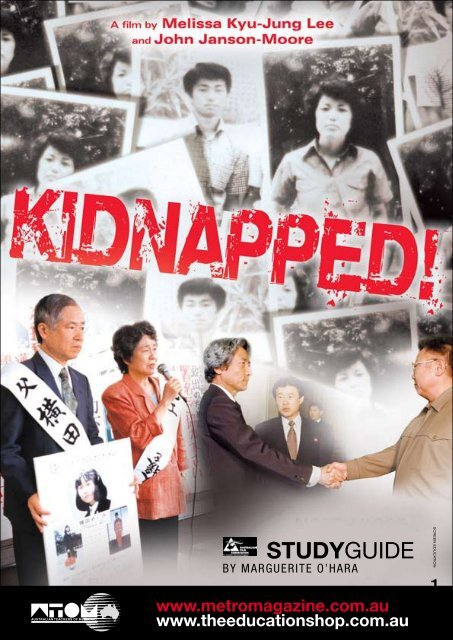
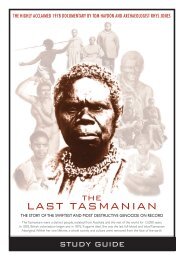






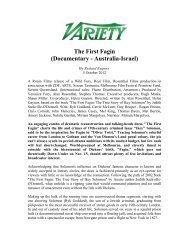

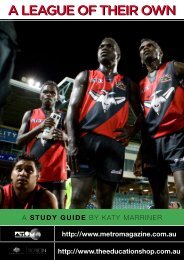

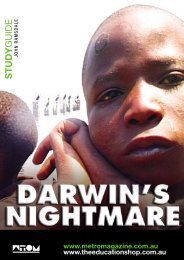
![to download FROHE OSTERN! [HAPPY EASTER!] - Ronin Films](https://img.yumpu.com/33740736/1/184x260/to-download-frohe-ostern-happy-easter-ronin-films.jpg?quality=85)
